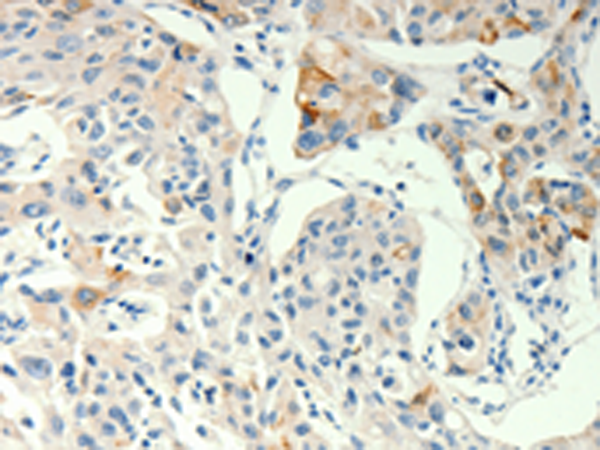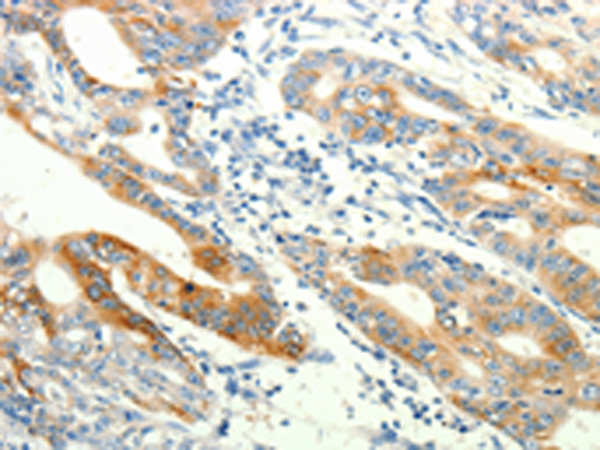

| WB | 咨询技术 | Human,Mouse,Rat |
| IF | 咨询技术 | Human,Mouse,Rat |
| IHC | 1/25-1/100 | Human,Mouse,Rat |
| ICC | 技术咨询 | Human,Mouse,Rat |
| FCM | 咨询技术 | Human,Mouse,Rat |
| Elisa | 1/2000-1/5000 | Human,Mouse,Rat |
| Aliases | FEPS; ANKTM1 |
| Host/Isotype | Rabbit IgG |
| Antibody Type | Primary antibody |
| Storage | Store at 4°C short term. Aliquot and store at -20°C long term. Avoid freeze/thaw cycles. |
| Species Reactivity | Human |
| Immunogen | Synthetic peptide of human TRPA1 |
| Formulation | Purified antibody in PBS with 0.05% sodium azide and 50% glycerol. |
+ +
以下是关于TRPA1抗体的3篇参考文献及其摘要概括:
1. **"TRPA1 mediates formalin-induced pain"**
- **作者**: McNamara, C.R., et al.
- **摘要**: 该研究通过使用特异性TRPA1抗体和基因敲除小鼠,证明TRPA1通道在福尔马林诱导的炎症性疼痛中起关键作用。抗体阻断实验显示TRPA1活性抑制可显著减轻疼痛反应,支持其作为镇痛靶点的潜力。
2. **"ANTRXA1 is a polyclonal antibody targeting TRPA1 for functional studies"**
- **作者**: Chen, J., et al.
- **摘要**: 研究团队开发了一种多克隆抗体(ANTRXA1),用于检测TRPA1在背根神经节和感觉神经元中的表达。通过免疫组化和Western blot验证其特异性,并证实其在体外钙成像实验中对TRPA1激活的抑制作用。
3. **"TRPA1 antibody-based inhibition attenuates airway inflammation in asthma models"**
- **作者**: Mukhopadhyay, I., et al.
- **摘要**: 该研究利用TRPA1中和抗体在小鼠哮喘模型中干预,发现抗体处理显著降低气道高反应性和炎症细胞浸润,表明TRPA1在呼吸道疾病中的病理作用及治疗价值。
这些文献涵盖了TRPA1抗体的开发、功能验证及治疗应用,为相关研究提供了关键工具和理论支持。
TRPA1 (Transient Receptor Potential Ankyrin 1) is a calcium-permeable ion channel belonging to the TRP superfamily, widely expressed in sensory neurons, epithelial cells, and other tissues. It functions as a polymodal sensor, activated by noxious cold, reactive oxygen species, environmental irritants (e.g., mustard oil, acrolein), and endogenous inflammatory mediators. TRPA1 plays a critical role in pain signaling, neurogenic inflammation, and conditions like asthma, itch, and neurodegenerative diseases.
TRPA1 antibodies are essential tools for studying the channel's expression, localization, and function. They are used in techniques such as Western blotting, immunohistochemistry, and flow cytometry to quantify protein levels or map distribution in tissues. Specificity is crucial, as TRPA1 shares structural motifs with other TRP channels. High-quality antibodies (monoclonal or polyclonal) are validated using knockout controls to ensure reliability.
Research applications include investigating TRPA1's involvement in pathological processes, such as chronic pain mechanisms, airway inflammation, or chemotherapy-induced neuropathy. Antibodies also aid in drug discovery, helping screen TRPA1 inhibitors for therapeutic potential. Recent studies explore its role in non-neuronal cells (e.g., cancer progression, gut motility), expanding the scope of TRPA1-related research. Understanding TRPA1 regulation via antibodies remains vital for unraveling its complex physiology and translational relevance.
×